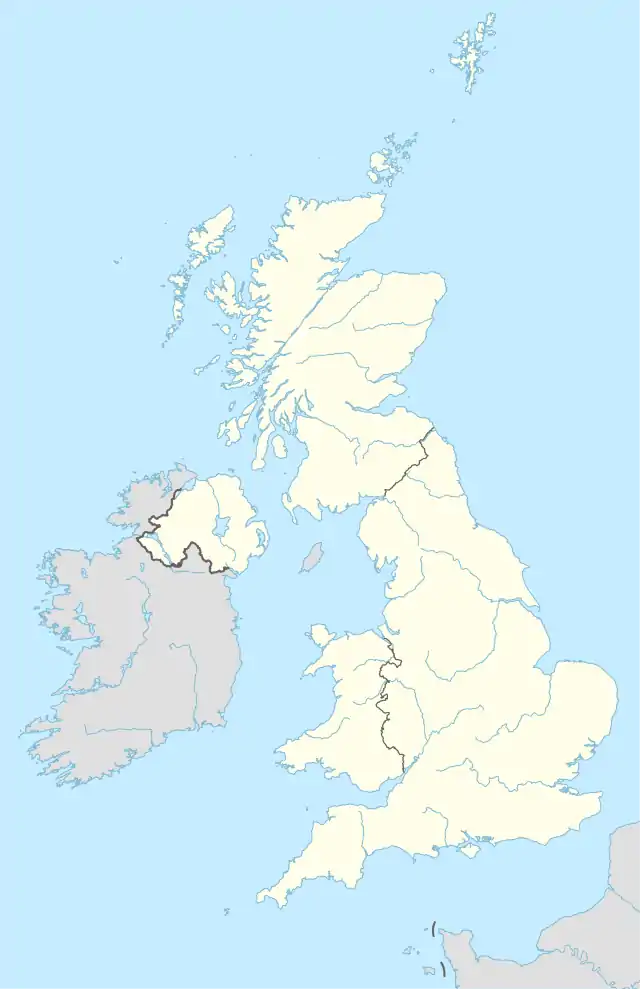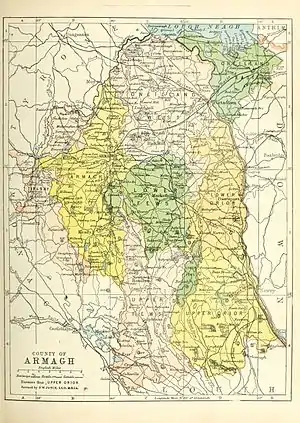Charlemont, County Armagh
Charlemont (Irish: Achadh an Dá Chora, meaning 'the Field of the Two Weirs') is a small village in County Armagh, Northern Ireland. It is situated within the Armagh City and District Council area. Charlemont Bridge joins the villages of Charlemont on the east bank of the River Blackwater and Moy on the west. It had a population of 109 people (52 households) in the 2011 Census.[1]
Charlemont, County Armagh | |
|---|---|
village | |
 | |
| Coordinates: 54°26′32″N 6°41′8″W |

History
In 1600, The 8th Baron Mountjoy was sent to the Kingdom of Ireland as the last Lord Deputy of Queen Elizabeth I. He joined a group of mercenaries who had been fighting in the valley of the Blackwater. Lord Mountjoy came to the place now known as Charlemont where he established a bridge of wood and a fort to guard the bridge in 1602. Prior to his founding of Charlemont Fort, the place had been called Achadh an Dá Chora, the 'Field of the Two Weirs', but it was renamed in his honour using his name and the French word for hill, 'Mont', i.e. Charlemont.
Charlemont remained a significant military post during the Stuart era, and was garrisoned by a detachment of the Irish Army. In October 1641 it was seized by rebels under the overall command of Sir Phelim O'Neill at the beginning of the Irish Rebellion of 1641. O'Neill may have captured a copy of the Great Seal of Scotland in Charlemont which he then used to produce a forged commission from Charles I, apparently ordering the Catholics of Ireland to rise.
In 1650, Charlemont was besieged by English Parliamentarian forces during the Cromwellian conquest of Ireland. The English took the fort from its Irish Catholic garrison under Sir Phelim O'Neill, despite taking heavy casualties. It was again an important post during the Williamite War in Ireland and its Jacobite garrison under Sir Teague O'Regan was placed under a lengthy siege until being forced to surrender to the Williamite forces of Marshal Schomberg in 1690.
The Troubles
On 15 May 1976, the Ulster Volunteer Force (UVF) launched two attacks on pubs in Charlemont. A bomb attack on Clancy's Bar left three Catholic civilians dead: 54-year-old Felix Clancy, 22-year-old Sean O'Hagan, and 41-year-old Robert McCullough.[2] Shortly after, a gun attack on the nearby Eagle Bar led to the death of another Catholic civilian: 49-year-old Frederick McLoughlin two weeks later.[3] A UDR soldier was later convicted for taking part in the attacks, which have been linked to the "Glenanne gang".[4]
Education
See also
References
- "Charlemont". Census 2011 Results. NI Statistics and Research Agency. Retrieved 22 April 2015.
- "Northern Ireland". House of Commons Hansard (17 May 1976 vol 911 cc 957-64). Retrieved 4 December 2011.
- "Sutton Index of Deaths, 1976". Conflict Archive on the Internet (CAIN). Retrieved 4 December 2011.
- Cassell Report Archived 2011-06-10 at the Wayback Machine (2006), pp. 53-54
